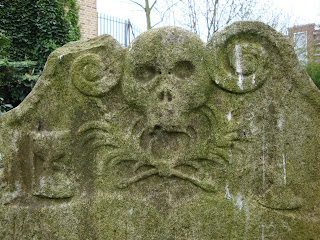St Pancras Old Church

Tucked away behind the Victorian grandeur of St Pancras railway station, St Pancras Old Church and gardens is an interesting, if obscure, attraction not so far away from the bustle of Euston Road and its environs. Like many churchyards it seems to exist within its own 'bubble' of peace and solitude, which makes for a pleasant moment before hitting the frenetic pace of the capital's shopping districts. I found out about the church through investigating my family history, several ancestors were either baptised, married or buried here, although with the railway station having encroached upon the burial ground at least twice it is likely that my ancestors are now underneath the railway arches.
There has been a place of worship on the site for hundreds of years before the railways came, tradition has it since the 4th century; St Pancras himself was a young man who was beheaded on the orders of the Emperor Diocletian in 304 for daring to be a Christian in a time when they were habitually persecuted. The present building, looking incongruous amongst the surrounding tower blocks of Somers Town, is an amalgamation of styles and periods, with Roman and Norman remains in the walls, and was heavily (and somewhat ruthlessly as the guidebook to the church suggests) restored in 1847 after it fell derelict with disuse. The churchyard was closed to burials in 1854 and landscaped into gardens just over twenty years later, around the same time the building of the railway station made it necessary to disturb many of the graves; famously the author Thomas Hardy was apprentice to the architect who was in charge of the operation. You can see the tree in the gardens today where Hardy apparently liked to sit, rather bizarrely surrounded by scores of displaced headstones.
Thomas Hardy's Tree
The 20th century has not been kind to the church. It was bombed in the Second World War and in the 1980s was vandalised by Satanists. Today, however, it shows no glimpse of its traumatic past; it is a small church, plainly decorated as most English churches are, with a few interesting memorials embedded into the walls, including one to William Platt and his wife, removed from Highgate chapel, which has a fine pair of heads carved in relief. I was interested to see that it still retained its 'Minstrels gallery' which looks over the nave as many churches have lost these.
The churchyard is famous for being the place where poet Percy Shelley fortuitously met the young Mary Godwin, future author of 'Frankenstein', whilst she was visiting her mother's grave - her mother being of course Mary Wollstonecraft, author of 'Vindication of the Rights of Women' (one of those books which is seem as very modern for its time). Today her grave is surrounded by daffodils which brought some colour to the plain headstone, which is also the resting place for her husband (and Mary's father) William Godwin, also famous in his day as a writer and philosopher.
The memorial to Mary Wollstonecraft and William Godwin

Because of the earlier tampering with the graveyard there are very few headstones left; along with the Godwins notable memorials include that to the architect Sir John Soane and his wife which is supposed to be the inspiration for the red telephone box, and Cecil Rhodes' family.

Because of the earlier tampering with the graveyard there are very few headstones left; along with the Godwins notable memorials include that to the architect Sir John Soane and his wife which is supposed to be the inspiration for the red telephone box, and Cecil Rhodes' family.
Hidden right in the corner of the graveyard was an interesting collection of headstones inscribed with various depictions of human skulls, obviously too dramatic for the Victorian sensibility!


Most of the information for this article came from 'St Pancras Old Church: A Church Guide' which is available from the church for £2. I recommend a visit, even if you are only looking for somewhere interesting to eat your lunch!


Comments
Thank you for this intriguing bio of the church and the people involved with it. I will visit next time I'm in that part of London. Great pictures.
Sally